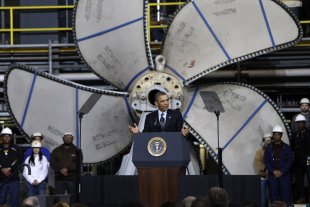This week's round-up of Good Reads include foreign policy advice for President Obama, how entrepreneurs are slowly revitalizing North Korea, a look at what makes a millionaire in the United States, and a dizzying visit to the window washers who clean the nation's highest buildings.
Private access gates surround multimillion- dollar homes in Dana Point, Calif.
Reed Saxon/AP/File
EnlargeUS presidents traditionally turn to foreign policy in their second terms. The executive branch operates with greater freedom in the international realm than in domestic policy, and world affairs are an appealing arena in which to cement a presidential legacy.
Skip to next paragraph David T. CookSenior Editor and Washington Bureau Chief
Cook is senior editor and Washington bureau chief of The Christian Science Monitor and host of the Monitor's newsmaker breakfasts.
Recent posts
' +
google_ads[0].line2 + '
' +
google_ads[0].line3 + '
Subscribe Today to the Monitor
The January/February issue of Foreign Policy magazine observes tongue in cheek that the paper required to print all of the white papers and op-eds urging President Obama to take various actions on the international scene ?would probably require chopping down the Amazon rain forest.?
The magazine counters with 10 tightly written essays on what Foreign Policy editor Susan Glasser calls ?ideas for what Obama could really accomplish in these next four years to make the world a better place ? concrete, achievable goals that, for the most part, wouldn?t even require the cooperation of Congress.?
Among the recommended actions: having Mr. Obama send the Senate the 1997 treaty on banning land mines (as 161 countries have already done); taking a tougher stance toward allies ? like Saudi Arabia and Bahrain ? with less-than-stellar human rights records; and working with Russia to reduce the hair-trigger, launch-ready alert status on both nations? nuclear-tipped missiles.
Capitalism and North Korea?s leaders
With North Korean leader Kim Jong-un having just overseen his nation?s third nuclear weapons test, The Economist magazine?s Feb. 9 cover story takes a very timely look at how ?capitalism is seeping through the bamboo curtain? with consequences the despotic Mr. Kim may not be able to control.
The North Korean famine of the 1990s, which killed up to 1 million people, triggered a breakdown in the government?s control over food distribution. So individual entrepreneurs began selling food grown in family plots. That market impulse has grown. ?It has become clear that other merchants today operate on a far more ambitious scale, exporting raw materials to China and bringing back consumer goods,? the Economist reports. So, the magazine says, money talks in today?s North Korea in ways that have a variety of destabilizing consequences.
For example, traders bring in computers, radios, and mobile phones, which diminish the Kim regime?s control of information. That allows some North Koreans to have a more acute sense of how impoverished their lives are compared with those of citizens of neighboring South Korea.
The role of the sexes has changed as women, who run some black markets, have become the breadwinners in their families. And there is a widening gap between the lives of market-involved elites centered in Pyongyang and the lives of the chronically underfed rest of the country.
Who are the millionaires?
The debate over how to reform the US tax code will be one of the top political stories of 2013. Whether America?s richest individuals are paying their fair share will be a key aspect of the debate. So it is useful to get a clearer picture of the financially fortunate.
?[T]he common conception of millionaires, on whom so much of the nation?s long-term fiscal viability depends, is largely a caricature,? writes Graeme Wood in the conservative National Review.
The first step in understanding millionaires, Mr. Wood writes, is a matter of definition. One group of millionaires are those who have assets like homes, savings accounts, and pensions that are worth a million dollars. ?The majority are working people,? Wood writes, and some 5.26 million households meet that definition.
The second group of millionaires consists of those who earn a million dollars or more a year. This much more rarefied group includes fewer than half a million households a year. Wood notes that many in this group are ?lucky one-timers,? folks who won the lottery or inherited from wealthy parents.
Only the 200,000 households with $20 million or more in assets have ?the financial equivalent of a perpetual-motion machine, capable of spontaneously replenishing itself and fairly reliably producing large amounts of money for its fortunate owner,? Wood says.
The window washers? life at the top
The New Yorker provides a vicarious glimpse into the dangerous, silent, and exhilarating world of skyscraper window washers for readers whose own jobs may offer less excitement.
The advent of computer design software made it practical for architects to create buildings with a different window configuration on every floor, ?turning Manhattan into a crystal garden of geometric forms and irregular shapes,? writes Adam Higginbotham. At the same time, the work of men with buckets and squeegees has remained just outside the reach of automation.
Thus it is that window washers still have to step out onto an 18-inch-wide walkway outside the 103rd floor of the Empire State Building.
When Mr. Higginbotham joined a window washer there, briefly, he writes, ?I sank to my knees in what may have resembled an attitude of pure terror.?
space shuttle enterprise ryan leaf ryan leaf luke kuechly brad miller chandler jones peyton hillis


 As this series was all about my early years and those of our own family, I had to include some Christmas photos. I?m not going to write much about the different Christmases here because I?ve written extensively about them in the Advent Series a year ago.
As this series was all about my early years and those of our own family, I had to include some Christmas photos. I?m not going to write much about the different Christmases here because I?ve written extensively about them in the Advent Series a year ago.






 This post is part of the?February Photo Collage Festival?and the?Family History Writing Challenge.
This post is part of the?February Photo Collage Festival?and the?Family History Writing Challenge.







